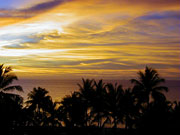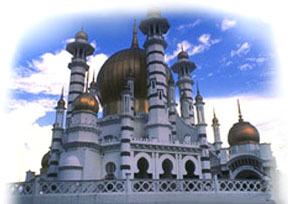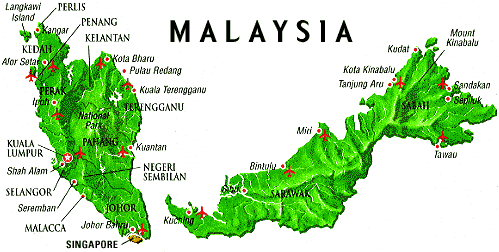 |
|
 |
 |
| Johore |
Johor is the third largest (19,984 sq km) and one of the most developed states in Peninsular Malaysia. It is situated at the southern tip of the peninsula, just across the Straits of Johor from Singapore (with which it is connected by a road and rail causeway). Johor's population exceeds two million people, comprising an ethnic mix of Malays, Chinese, Indians, and other groups. Its capital is Johor Bahru |
| Malacca |
If the ultra-modern architecture and forward-looking citizens of Kuala Lumpur symbolize Malaysia's hopes for the future, then the quiet, seaside city of Malacca, about 150 kilometers to the south, is the guardian charged with the reflective task of preserving its past. Five hundred years ago, an extraordinary empire rose and fell here, its power and dreams suddenly caught off-gaurd by the dawn of the Colonial Era. |
| Selangor |
Selangor, with an area of approximately 8,000 sq. km, extends along the west coast of Peninsular Malaysia at the northern outlet of the Straits of Malacca. Its advantageous geographic position and rich natural resources have made Selangor the most prosperous state in Malaysia. Today it has the distinction of being the most populated state in Malaysia, with about 3.75 million inhabitants. A large proportion of Selangor's population lives around the Federal Territory of Kuala Lumpur, though the balance is now shifting towards its new capital, Shah Alam.
|
| Kedah |
Kedah has the distinction of being the "Rice-bowl of Malaysia" - a term that takes on aesthetic significance when one sees the rice fields for themselves: the flat expanse of padis against a backdrop of rolling hills provides a picture of utter serenity that lulls the senses.
Off Kedah's western shores are clusters of sun-drenched islands that comprise the legendary archipelago of Langkawi, easily the most popular resort location in the country. More than a land of mere scenery, however, Kedah is also the site of Malaysia's most extensive ruins. In the Bujang Valley are the sprawling remains of a Hindu kingdom believed to date back to the 6th century A.D.
Like Malaysia's other states, Kedah has its share of rich cultural traditions, songs and dances. Due to its close proximity to Thailand, some of these traditions are Thai in influence and origin, and faces of Kehah's people often bear signs of Thai or Achinese ancestry.
|
| Penang |
Penang needs little introduction to many visitors to Malaysia, having long been known as one of Southeast Asia's finest destinations. Penang's outstanding beaches and exotic sights have made it one of the most popular destinations in the region. |
| Perak |
Perak covers an area of 21,000 square kilometers, making it the second largest state in Peninsular Malaysia (Pahang is larger). The state is situated along Malaysia's western coast at the northern approach to the Strait of Malacca. It extends deep into the peninsula, with its eastern border marked by mountains of the Main Range.
|
| Pahang |
Pahang is the largest state in Peninsular Malaysia and is situated in the eastern coastal region. The state's 35,964 sq. km encompasses a remarkable range of Malaysia's many different environments, from the majestic peaks and cool hill regions of the state's western region to the miles of soft sand beach along the South China Sea. Pahang's nearly one million people constitute a representative mix of Malaysia's three main ethnic communities-- Malay, Chinese, and Indian.
|
| Negeri Sembilan |
Negeri Sembilan translated literally means "Nine States," so named because it comprises a federation of nine states. It is located on the south-west corner of Peninsular Malaysia and encompasses an area of 6,645 sq km including a 48-km gentle coastline. Seremban, the capital of Negeri Sembilan, is 64 km south of Kuala Lumpur.
Negeri Sembilan is noted for its Minangkabau-styled architecture, reflecting the influence of the State's first inhabitants from Sumatra.
|
| Perlis |
Perlis, the smallest state in Malaysia, lies at the northwestern extremity of the Malay Peninsula; its western coastline borders the Straits of Malacca. Bounded by Thailand in the north, and by Kedah to the east and south, it measures approximately 759 sq. km and has a population of 175,000. Kangar is the seat of the State Government.
|
| Kelantan |
Coast of Kelantan is the northernmost state on the East Peninsular Malaysia. It has an area of 14,931 square kilometres. Rustic settings of picturesque vampings (villages) amidst padi-fields give insights into a way of life that has endured the passing of time. Kelantan's history dates to between 8000-3000 B.C. Chinese historical documents chronicle the existence of a government which had links with China, when Kelantan was referred to as 'Ho-lo-tan'.
|
| Terengganu |
Terengganu is one of the three east coast states on Peninsular Malaysia. It has a land area of 12,995 square kilometres and 225 kilometres of picturesque coastline. Kuala Terengganu, its capital, stands on the bank of the Terengganu river.. |
| Sabah |
Located at the northeast corner of Borneo, Sabah was known in ancient times as the "Land Below The Wind" because it lies below the typhoon belt. Sabah's terrain is rugged, with Mt. Kinabalu, at 4,101 metres, dominating the surrounding landscape. It has a wide diversity of flora and fauna, as well as one of the world's largest rainforests. Sabah's people comprise 31 different indigenous groups, including the Kadazans, Muruts, Bajaus, Kedayans, Sulu, Bisaya, Rumanau, Minokok, and Rungus.
International access to Malaysia'a eastern gateway is through Sabah's capital, Kota Kinabalu, which receives flights from Kuala Lumpur, Johor Bahru, Kuching, Singapore, Hong Kong, Manila, Brunei, Jakarta, Seoul, and Taipei. Domestic travel in this vast state is via daily flights between Labuan, Sandakan, Lahad Datu, and Tawau, though large areas are still inaccessible. A rail network stretches from Kota Kinabalu to Tenom, and buses, taxis, and boats are also available.
|
| Sarawak |
Sarawak is the largest state in Malaysia, an outback of sheer beauty rich in resources such as pepper, cocoa, palm oil, timber and oil. With an area of 124,450 sq. km, it is a region of endless fascination, possessing the largest cave chamber in the world, verdant jungles, unique fauna and flora, white beaches, and remote islands. Its population of 1.5 million people is as rich and varied as the land.
|
| Kuala Lumpur |
Kuala Lumpur is situated midway along the west coast of Peninsular Malaysia, at the confluence of the Klang and Gombek rivers. It is approximately 35 km from the coast and sits at the centre of the Peninsula's extensive and modern transportation network. Kuala Lumpur is easily the largest city in the nation, possessing a population of over one and a half million people drawn from all of Malaysia's many ethnic group
|
To know more about my country, please click the following website.
www.geographia.com/malaysia/ |
| Home |
About Me |
Family |
Country |
Tazkirah |
Autograph |
| Copyright © May 2005. Masyfu'ah Mokhtar. ® IIUM, Gombak. All right reserved |